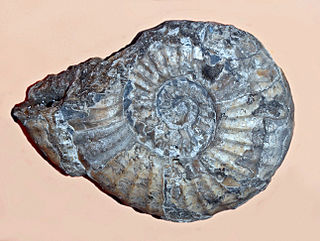
Dactylioceras was a widespread genus of ammonites from the Lower Jurassic period, approximately 180 million years ago (mya).

Audaxlytoceras is an extinct genus of lytoceratid ammonites.

Gleviceras is an ammonite genus that lived during the Early Jurassic Period, found in Canada, Hungary, Mexico and the United Kingdom.
Bifericeras is a Lower Jurassic ammonite belonging to the family Eoderoceratidae, and sometimes placed in the subfamily Xipherceratinae. Whorls are strongly depressed, but still evolute in coiling. The early growth state is prolonged, and smooth, followed by a late growth stage with rounded, straight, bituberculate ribs.

Lytoceratina is a suborder of Jurassic and Cretaceous ammonites that produced loosely coiled, evolute and gyroconic shells in which the sutural element are said to have complex moss-like endings.
Euaptetoceras is an evolute hildoceratoid ammonite from the lower Middle Jurassic, included in the family Hammatoceratidae and the subfamility Hammatoceratinae. The genus may be a junior synonym for Eudmetoceras of Buckman, 1920.

Hildoceras is a genus of ammonite from the Jurassic period in the family Hildoceratidae. The shells are characterized by a narrow discoidal evolute shape, keeled venter, concave ribs along the outer flanks, and a shallow spiral groove running along smooth inner flanks. Whorls slightly overlap, cross sections are compressed. The ventral keel is bordered on either side by a shallow groove. The genus was named by Alpheus Hyatt after Saint Hilda in 1876.

Psiloceratoidea is a superfamily of Early Jurassic ammonoid cephalopods proposed by Hyatt in 1867, assigned to the order Ammonitida. They were very successful during Hettangian and Sinemurian. Last of them, family Cymbitidae and genera Hypoxynoticeras and Radstockiceras survived into Early Pliensbachian.

Oxynoticeratidae is a family of true ammonites included in the superfamily Psiloceratoidea.

Macrocephalites is a genus of the stephanoceratoid ammonite family Macrocephalitidae, diagnostic of the Callovian stage of the Middle Jurassic. Three subgenera, Dolikephalites, Kamptokephalites, and Pleurocephalites are recognized in addition to Macrocephalites itself, with Indocephalites tentatively included as the fourth.
Pachyceratidae is a family of Perisphinctoidean ammonites from the upper Middle - and lower Upper Jurassic. Genera within the Pachyceratidae have shells that are in general moderately involte but with most of the inner whorls exposed; whorl sections subquadrate to subtrapezoidal, with rounded venter. Ribbing is strong, in some sharp. Primary ribs typically branch above mid flanks into twos, threes, and even fours.
Hecticoceras is an ammonite genus belonging to the haploceratoid family Oppeliidae, that lived during the Middle and Late Jurassic, from the Callovian. Hecticoceras may be seen as a series of some nine subgenera, beginning with the lower Callovian H. (Hecticoceras) and H. (Hecticoceratoides) and ending with the lower Oxfordian H. (Pseudobrightia) and H. (Eochetoceras). Hecticocerassensu lato and Prohecticoceras from the underlying Bathonian form the oppeliid subfamily, Hecticoceratinae.

Harpoceras is an extinct genus of ammonite belonging to the family Hildoceratidae. These cephalopods existed in the Jurassic period, during the Toarcian age from the Falciferum zone to the Commune subzone of the Bifrons zone. They were fast-moving nektonic carnivores.

Harpoceratinae is an extinct subfamily of cephalopods belonging to the family Hildoceratidae. Ammonites of this subfamily had involute and compressed shells with strong keels. Keel might be rarely missing, but this is considered to be an abnormality. This has been observed both in Cleviceras and Harpoceras and called as genus Monestieria, which is now known to be invalid. Another example is Pseudolioceras, whose unkeeled specimen was used as type for description of invalid genus Praehaploceras. Oxyconic forms of this subfamily does not have any keel. Ribs were single, but in some genera also bifurcating with shapes from sigmoidal to falcate. Sometimes, shell can have only striate ribs or is smooth. Tubercules are rare. Dimorphism is known in some genera and it is observable mostly in size. Macrochons can be 4, to 6 times larger than microconchs. As an example, macroconchs of Pseudolioceras are more than 150mm in diameter, while adult microconchs are only 35-50mm. There are big size differences even within dimorphs. Specimens ca be 2, or sometimes even 3 times bigger than other specimens of same dimorph.
Ochetoceras is a genus of ammonites, belonging to the Oppeliidae, that lived during the Late Jurassic from the early Oxfordian to the early Tithonian, and type for the subfamily Ochetoceratinae.

Hammatoceras is a genus of ammonites belonging to the family Hammatoceratidae which lived during the Toarcian stage of the Early/Lower Jurassic between about 184 and 175 million year ago.
Ovaticeras is an extinct genus of cephalopod belonging to the family Hildoceratidae. These cephalopods existed in the Jurassic period, during upper Pliensbachian and lower Toarcian. Its fossils were found in Europe, North Africa and possibly also in Canada and Vietnam. It might have evolved from Harpoceras falciferum and died out without leaving any descendants.
Porpoceras is genus of ammonite that lived during the early and middle Toarcian stage of early Jurassic. Members of this genus existed from uppermost part of the Harpoceras serpentinum zone to the Haugia variabilis zone. Their fossils were found in Europe, Asia, North America and South America.

Sydney Savory Buckman was a British palaeontologist and stratigrapher. He is known for his studies of extinct marine invertebrates, especially the Brachiopoda and Ammonoidea of the Jurassic era.

Hildoceratinae is an extinct subfamily of cephalopods belonging to the family Hildoceratidae. Ammonites of this subfamily had shells with elliptical or quadrate whorl section with keel or tricarinate, bisulcate venter. Ribs were variable, from falcate to strongly angled and from fine to strong. They can be interrupted by spiral groove in midlateral part of the shell. While some species can be smooth, strongly ribbed ones can have tubercules. Microconchs have short lapplets that is in its shape similar to the shape of growth lines in spiral midlateral groove.











